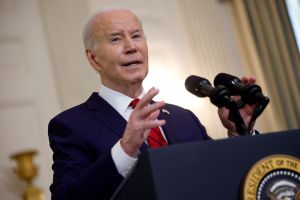The tribes of the modern GOP
For years, the defining question in the GOP has been where you stood in relation to Donald Trump: an enthusiastic supporter, disgusted NeverTrumper or somewhere between the two.
There was, of course, always more to it than this. But Trump loomed so large that it was easy to miss a lot of that detail.
A new study from Pew brings some much-welcomed nuance to this story. Titled “Beyond Red vs Blue,” they describe the deep divisions between the two party’s coalitions. The study slices the electorate into nine groups that share similar values and policy priorities.
The four Republican-aligned groups are:
Faith and flag conservatives, who are staunch right-wingers, fiercely patriotic, want Christianity to be a bigger part of American public life, say that America stands above other countries and support politicians who back Trump’s claim that he won the 2020 election. They account for 23 percent of the Republican-leaning portion of the electorate.
Committed conservatives, who are very conservative, especially on economics issues, support a foreign policy that works with America’s allies, are likely to name Ronald Reagan as the best president in recent history and overwhelmingly backed Trump in 2020 but are now lukewarm in their support. They account for 15 percent of Republican-leaning voters.
The populist right section of the electorate favor highly restrictive immigration policies, are critical of big business and the fairness of the economic system and are strong Trump supporters. One in four of the voters in the Republican-aligned groups are populist right.
Ambivalent right voters have conservative views on government and the social safety net, take a more liberal view on immigration and social issues than other Republican groups, don’t feel especially at home in the GOP and want Trump to leave politics. They account for a fifth of Republican-aligned voters.
Then there are the swing voters in the middle, whom Pew calls the stressed sideliners. They aren’t especially politically engaged, are financially stressed, and lean liberal economically but take more conservative views on other issues.
These tribes, Pew reports, are reasonably united on most social and cultural issues. They are also more united on the proper scope and scale of government, with more than two thirds of every group sharing the belief that government does too many things that would be better left to individuals and the private sector. The exception is military spending, where none of the groups want to see a reduction.
The biggest divide is on business: the populist right is at odds with the rest of the coalition on whether corporations make a fair and reasonable amount of profit.
Overall, the picture presented is not of a party irreversibly wedded to Trump and everything he says and does. Perhaps the most important takeaway isn’t about the internal rifts in the GOP coalition, but the so-called stressed sideliners. They are the largest group in the electorate, outnumbering the hardliners on both sides and only half of them voted in 2020. A Republican Party that can overcome its internal divisions and tap into this group is surely one that will be difficult to beat.
*** Sign up to receive the DC Diary in your inbox every weekday ***
Can numbers be ‘right-wing’?
Can numbers be right-wing? The answer is yes, according to White House chief of staff Ronald Klain. According to Politico, Klain leveled the charge of conservative bias in response to the Penn Wharton Budget Model. Their latest analysis of the Build Back Better reconciliation package finds that the legislation would add $500 billion to the national debt over the next decade. The White House claims the correct figure is $0.
The PWBM is the source of sweaty palms in the West Wing because it is a favorite source of analysis for Joe Manchin. But it also points to trouble in the future, when the all-important Congressional Budget Office analysis comes to its own conclusions about the fiscal consequences of Build Back Better.
Jason Furman, chair of the Council of Economic Advisors during the Obama administration, said of the model: “I don’t think they’re biased… I think the Penn Wharton budget model is pretty good, but I think there’s a huge error band around it, like there is around any forecast… I think it is one useful thing to look at, but I wouldn’t treat it as the truth.”
Kamala in Paris
Is there any other ally that Americans love to antagonize more than the French, asks my colleague Matt Purple. “Call it a sibling rivalry between children of the Enlightenment; call it a clash between social democracy and rugged individualism. Whatever you call it, just don’t go canceling a submarine agreement at the last minute for the love of God,” he writes. But help is on the way: the vice-president is in Paris. Let’s hope Harris is more popular there than she is back home, where her approval rating is a woeful 28 percent.
What you should be reading today
Amber Athey: The inanity of corporate mask policies
Taylor Millard: Democrats’ new tobacco tax would hit the poor hard
Alexander Larman: How Meghan Markle wins the White House
Arvin Bahl, City Journal: Coalition of the sane
Luke Broadwater and Mark Mazzetti, New York Times: At the Willard and the White House, the Jan 6 panel widens its net
Eliza Collins and Siobhan Hughes, Wall Street Journal: Republicans’ efforts to retake the Senate stumbles in New Hampshire
Poll watch
President Biden Job Approval
Approve: 42.6 percent
Disapprove: 51.8 percent
Net approval: -9.2 (RCP Average)
How serious do voters think immigration is as an issue at the moment?
Very serious: 49 percent
Somewhat serious: 32 percent
Not too serious: 13 percent
Not at all serious: 6 percent (Harvard/Harris)


















